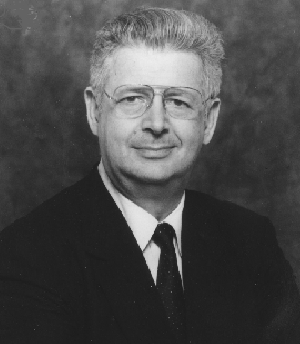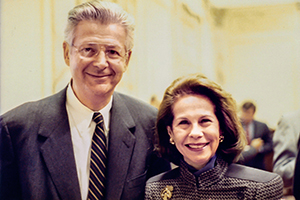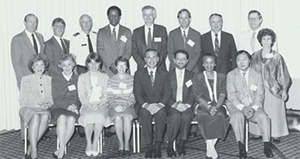Profiles of Pioneers Who Led the Way for the NIDCD

An explosion of knowledge.
Robert J. Ruben, M.D., was in Beijing, China, when he received a telegram on October 28, 1988, that President Reagan had signed P.L. 100-553. He recalls, “I was very gratified, but I also realized that there was much work to be done” to set up the new hearing and communication disorders institute at the NIH.
Ruben’s interest in the auditory (hearing) system began as an undergraduate at Princeton University, where Ruben conducted hearing tests in reptiles under the mentorship of Ernest Glen Wever, Ph.D. He continued fostering this interest in medical school at Johns Hopkins University while completing his residency in otolaryngology under the direction of John Bordley, M.D. He became the first otologist to complete a fellowship at the NIH, where he researched the developmental biology of the inner ear. Today, Ruben is a distinguished university professor and director of the Clinical Research Center for Communicative Disorders at Albert Einstein College of Medicine in New York.
From 1983 to 1985, Ruben chaired the National Committee for Research in Neurological and Communicative Disorders (NCR), a coalition of scientific organizations that successfully advocated to Congress for increased program support for the National Institute of Neurological and Communicative Disorders and Stroke (NINCDS). The institute, which eventually became the National Institute of Neurological Disorders and Stroke, was the first home for hearing and communications research at the NIH.
“Although our efforts increased appropriations for NINCDS and for neurological disorders, they did little for increasing research focus for communication disorders,” recalls Ruben. “There was really a need for fundamental research in this area, and [I believed that] the best way to achieve this was to form a new institute.”
Commitment of Many

Aware of the challenges of establishing a new NIH institute dedicated to research in communication disorders, Ruben organized a scientific conference in Denmark in June 1987. “I decided to bring together an international group of scientists who would document the state of the science of hearing loss in children, what science was needed, and what science was reasonable to accomplish,” says Ruben. The conference report, “Biology of sensorineural hearing loss in children, Report of symposium held in Holte, Denmark, 14-17 June, 1987,” served as the scientific basis for the need for a new NIH institute, according to Ruben.
Ruben also recognized the importance of gaining the endorsement of professional societies. He worked with the leaders of the American Academy of Otolaryngology-Head and Neck Surgery to create a presence in Washington, D.C. through a political action committee. He also worked with the Association for Research in Otolaryngology, whose members were primarily scientists, and organized a panel discussion about the proposed institute during the group’s January 1988 meeting.
I decided to bring together an international group of scientists who would document the state of the science of hearing loss in children, what science was needed, and what science was reasonable to accomplish.
Working with Congress

Of course, getting members of Congress to support the legislation was also crucial. Representative Claude Pepper (D-FL), chairman of the powerful House Rules Committee as well as the Subcommittee on Health and Long-Term Care, initiated the congressional effort.
“He had a large office in the attic of one of the House office buildings, and he was sitting at the far end behind a formidable desk,” says Ruben, describing his first meeting with Pepper. “He was very pleasant and courtly, but he also had a substantial hearing problem. After a little while, with many repeats and assistance from his staff, Representative Pepper understood the need for the NIDCD and became a strong supporter.”
Pepper readily offered the help of one of his staffers, Peter Reinecke who would draft the bill establishing the NIDCD. The text of the bill was eventually merged into H.R.3361–the National Research Institutes Reauthorization Act of 1988.
On the other side of the Capitol, Senator Tom Harkin (D-IA) introduced S.1727. Ruben says that Senator Harkin “was always available, listened, gave good advice, and was the most instrumental person in Congress in establishing the NIDCD.”
There was also an “element of luck” in making Congress aware of deafness and communication disorders, says Ruben. While Ruben, Geraldine Dietz Fox, (a woman with hearing loss who became a champion for deafness and hearing research), and others were visiting members of Congress to advocate for the establishment of the NIDCD, students at nearby Gallaudet University held a mass protest in March of 1988. They wanted a deaf president to lead the university. “This raised awareness about deafness not only to Congress but also to the world,” says Ruben.
Advancing Our Understanding of All Human Communication
One of the NIDCD’s most well-known contributions to public health affects our youngest citizens. Ruben notes that the NIDCD’s support of “research on universal newborn hearing screening positively affects the lives of tens of thousands of American infants, and [the scientific advances] set the standard for early hearing detection and intervention throughout the world.”
“There has been an explosion of knowledge concerning the genetic and molecular factors that cause certain types of hearing loss,” he adds. “There have been few effective interventions for these. It is only a matter of time, however, until we change that. Once a treatment is determined, it could lead to a standard of care that can be implemented throughout the world.”
Ruben emphasizes that the NIDCD’s accomplishments over the past 30 years extend beyond hearing research. “Without the NIDCD including language and language disorders as part of its mission, understanding the biological basis of language may not have happened,” he says. “Language is the major outcome measure of almost all of the medical interventions in otolaryngology, including hearing, voice, and speech.”
“The establishment of the NIDCD has and will continue to supply resources to further the advancement of our understanding of all human communication,” says Ruben.
Without the NIDCD including language and language disorders as part of its mission, understanding the biological basis of language may not have happened.
Read more about the history of the NIDCD:

